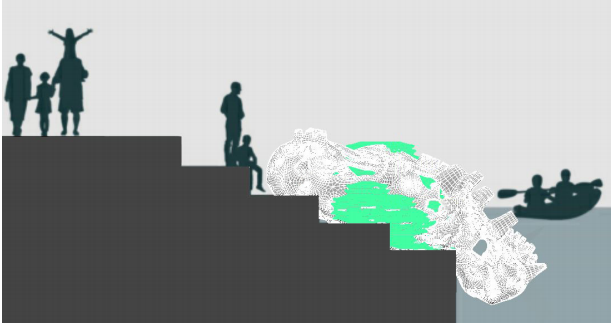In the recently published ‘Recycled Sustainable 3D Printing Materials for Marine Environments,’ the authors—involved in the Bio-Shelters Project—venture into the realm of sustainability and recycling in 3D printing, but they also heavily explore the ever-growing science of materials during a three-phase project made up of not only designers and architects but also experts in materials and marine ecology.
For this project, the team used a base of both conventional and alternative materials, to include:
- Clay
- Sugar
- Cellulose fiber
- Recycled paper
- Wood and polystyrene waste
- Concrete
- Gypsum
Not afraid to work with materials that might be considered ‘radically innovative and experimental,’ the researchers are focused on applying their findings to marine applications:
“The approach to the material design of this project in this current phase is based on the same principle as commercially available sustainable filament products including recycled wood filaments, recycled brick filaments and, recently, algal filament,” explain the authors. “These products rely on a certain percentage of base-bonding material such as ABS plastic or PLA to ensure fabrication stability during printing as the base materials melt at a consistent temperature, ensuring consistent bonding of each subsequent layer.”
In many cases, the teams working with the Bio-Shelters project are required to build structures like seawalls, demonstrating a great example of why strong yet environmentally sustainable materials are necessary.
“The design of the 3D print structure is a data-driven approach that incorporates ecological data to optimize the form for growth and survivorship of marine species under the environmental conditions of the installation site as well as being an integral part of the design project and the site,” stated the researchers.
Testing materials meant adding and subtracting elements from the base combination; for example, during their research, the team may have subtracted items like sand or crushed rock from concrete mixes, as well as adding substitutes like vermiculite or iron oxide. Part of their build material also includes oyster shells that are considered waste at Sydney fish markets.
Sustainable materials can be used to create bio-shelters that are attached to seawalls, adding to their ‘ecological value.’
“Estuaries in Australia, the United States and Europe have had more than 50 percent of their natural coastline modified with artificial structures, such as seawalls, which support low biodiversity and few ecosystem services as compared to the natural habitats they replace,” state the researchers.
Such structures help with seawalls, as well as:
- Stabilization of reclaimed land
- Protection of coastal infrastructure
- Enhancement of fisheries
- Maintenance of clean water, promoting filter feeders
While the use of oyster shells has been present in marine projects, artificial reefs, and more, so far, they have not been used in 3D printing. In this research project, the team used an FDM 3D printer for experimenting with and testing of materials. Design variables included:
- Material composition
- Scale of perforations
- Texture
- Structural integrity
While there was a strong focus on the performance and effectiveness of structures, the researchers also emphasized the need for ecological performance too, requiring sustainable construction. Materials included standard concrete mix with the addition of crushed oyster shells, vermiculite, and crushed rock and sand.
“Oyster shells were sourced from the Sydney Fish Market vendors and crushed with a Rock Crushing Machine and a Ball Mill located at the UNSW Faculty of Mining,” explained the researchers.
Material Tests with reclaimed oyster shell as aggregate, as part of an art project to test material.
A series of silicone molds were produced, with 30 untextured tiles, and 30 with ‘same-size perforations.’
“To date, sixty 200 x 200 x 50mm tiles have been fabricated and are currently in the ocean for testing,” concluded the researchers. “The tiles were secured to a steel mesh frame and submerged into the ocean in the intertidal zone at Blackwattle Bay, Sydney to test the structural integrity of the material in marine conditions and more importantly to test how they interact with marine life.
“These material test components will stay in the ocean for 6 weeks and 6 months and then be evaluated by marine scientists and engineers to test their ecological and structural performance and efficacy.”
As 3D printing has continued to increase in momentum, the issue of recycling grows too. Most users are concerned about the impacts on the environment and have launched many different projects around the world from recycling powder into filament, taking plastic full circle, and making composting a reality.
What do you think of this news? Let us know your thoughts! Join the discussion of this and other 3D printing topics at 3DPrintBoard.com.
[Source / Images: ‘Recycled Sustainable 3D Printing Materials for Marine Environments’]